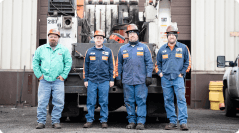The 8 Drivers of Construction Productivity
Written by Wally Adamchik
January 18, 2022
Do you want to exert more leverage and have a bigger impact on the job and on the bottom line? Take a look around. Chances are, you’ll notice one thing all the best contractors have in common.
They always have the right stuff — the right labor, the right materials, the right tools, the right equipment. All the right stuff, on site, right when they need them. And it’s all coming from short interval scheduling.
So what can you do to increase the quality of your short interval scheduling? In this lesson, Adamchik outlined the nuts and bolts that will give you the keys to the kingdom: the eight drivers of construction productivity.
The power is not in the plan, it’s in the planning.
There are probably many of you who’re already doing short interval schedules, and you’re saying, these things are not worth the paper they’re written on, because they’re just going to change.
“Yeah, I know,” Adamchik said. “No plan survives contact with the enemy, so get over it. Because the power is not in the plan, it’s in the planning. Every battle starts with a plan. And then they make corrections, after they think it through. So yeah, your short interval schedule is going to change.”
Of course, the better the job you do with your short interval schedule, the less likely it is to change. But when it does change, you need to have thought through plans A, B, C, and D. And plan E as well. “When you’ve thought it through, you’re better able to absorb the blows of these changes,” Adamchik pointed out. “And when you’re out on the job next week and something goes wrong, you can quickly adjust.”
Reduce your recoverable lost time.
In the Dirt World, there are three ways to measure time:
- primary time, or time spent working
- secondary time, when you’re planning and staging materials
- recoverable lost time, which is time you’ve lost to waiting around
If you want to make more money, you need to reduce your recoverable loss time. “Here’s the secret,” Adamchik said. “The more time you spend in secondary time, the more time you’ll be able to spend in primary. Better job planning, and thinking through how we’re going to do the work and how we’re going to lay things out, reduces your recoverable loss time. And this in turn increases your primary time. It all solves itself when you reduce your recoverable lost time.”
The 8 drivers of construction productivity.
The following eight drivers of construction productivity are your points of leverage. “These are points where you can exert force on the job in a positive way,” Adamchik explained. “Now, some of these are directly in your control, and some you’ll need a bit of help with. But if you have anything to do with construction operations, this is the checklist to go through as you’re thinking through how you can drive productivity.”
1. Labor
When it comes to labor, you need the right people. “What do I mean by ‘right’?” Adamchik asked. “Well, first, they need to be here, they need to be trained, and they need to have the right morale and the right motivation to show up and do this nasty thing called dirt in a productive and efficient way.”
2. Materials
Ask yourself, do I have the right materials when I need them? Or am I scrambling around for stuff? “If you don’t have the materials to install the project or to do the work you bid to do, you’re done,” Adamchik said. “You’ve driven your productivity south.”
3. Tools
Small hand tools come next on the list. If you want to be productive, you need to have the right tools. “Do you have the right tools when you need them?” Adamchik asked. “Sure, I can handle a nail with a screwdriver handle, but that’s not going to be as efficient as if I had a hammer.”
4. Equipment
Equipment — larger machinery, like bobcats and loaders — has to be there when you need it. But while you need to have the right equipment at the right time, there’s a planning and coordination aspect that you can’t ignore.“There’s a dark side to this one,” Adamchik explained. “Let’s say you need that D7 you’ve been hoarding at some point. But if that job site over there needs a D7, and you’re saying, no, I need it, well, then they don’t get their D7. And they’re either delayed, or they’re going to rent one. And there are costs associated with both.”
5. Information
You also need to have the right information to do what you need to do. “We have the opportunity these days to access information in more ways than we ever have,” Adamchik said. “But for some reason, information doesn’t flow at the rate and to the extent that it could. We have issues, whether it’s at the start of the project or day-to-day. And the thing is, if we have the right information when we need it, we’re more efficient.” And while we're focused on short interval scheduling here, you also need to be educating people about the Dirt World over time so you can have the good, productive team you want.
6. Access
Access is an obvious driver of productivity. “If you can’t get access to the area you’re supposed to be working, you’re done,” Adamchik pointed out. “And this is where a Plan B would come into play if you had one. Maybe it’s because of the weather, or a subcontractor not getting out of the way when they’re supposed to. But whatever the reason, if we don’t have access to the work, we can’t do the work.”
7. Coordination
Coordination is another big thing, because we’re usually not out there by ourselves. “Whether there’s another contractor, or an owner’s rep, or government inspectors, it’s rare that we get out there and we can just start moving dirt,” Adamchik said. “So while coordination might not be part of your daily habit patterns, you absolutely need to be aware of it. You need to be talking about it internally, both in the field and in the office. Help each other be successful, and coordinate.”
8. Safety
The final driver is safety. And it’s simple. “If you have an accident on the job, the job shuts down,” Adamchik noted. “And when the job shuts down, it doesn’t matter how good a job we’re capable of doing. Labor stops, tools stop, our equipment stops. Nothing’s happening, and nobody’s making money.”
Takeaways.
These eight drivers of construction productivity are your keys to the kingdom:
- labor
- materials
- tools
- equipment
- information
- access
- coordination
- safety
It can be easy to just focus on a couple of these drivers, and forget the rest because they’re someone else’s responsibility. But when you focus and spend your time on leveraging these drivers, life gets better. As Adamchik said, “Give it a try.”














